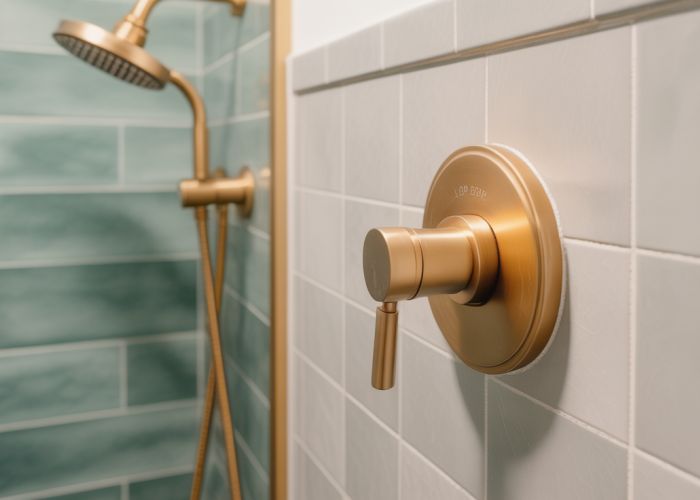Understanding the optimal shower diverter height is crucial for bathroom functionality. Plumbing codes often dictate minimum height standards, while ergonomics play a significant role in user experience. A professional installer from a reputable company, such as Roto-Rooter, can ensure compliance with these codes. Determining the shower diverter height requires careful consideration of both accessibility and the specific showerhead selected.

Shower Diverter Height: Achieving Optimal Placement
The placement of your shower diverter valve is crucial for both comfort and accessibility. This guide provides comprehensive information to help you determine the ideal shower diverter height in various scenarios.
Understanding the Importance of Shower Diverter Height
Proper shower diverter height significantly impacts the user experience. A diverter placed too high might be difficult for shorter individuals to reach, while one too low could be inconvenient or require excessive bending. Consider these factors:
- Accessibility: Is the height suitable for all users, including children, elderly individuals, or those with mobility limitations?
- Ergonomics: Is the diverter easily reachable without straining or excessive reaching?
- Aesthetics: Does the placement visually complement the shower design?
- Plumbing Practicality: Are there existing plumbing constraints that might influence placement?
Standard Shower Diverter Height Recommendations
While personal preference plays a role, industry standards offer a general guideline for shower diverter height.
Recommended Height Range
The generally accepted range for shower diverter height is 40 to 48 inches (101.6 to 121.9 cm) from the shower floor. This range provides a good balance of accessibility and ease of use for most adults.
Factors Influencing Height Selection Within the Range
Consider the following when choosing a height within the 40-48 inch range:
- Average Height of Users: If most users are taller than average, opt for a higher placement within the range.
- Presence of Children: If young children frequently use the shower, prioritize a height closer to 40 inches, or consider installing a separate handheld shower with a lower diverter.
- Shower Configuration: The location of other fixtures, such as grab bars or shelves, can influence optimal diverter placement.
Considerations for Different Shower Setups
The ideal shower diverter height can vary depending on the type of shower setup.
Standard Shower/Tub Combination
In a standard shower/tub combination, the diverter is usually located on the tub spout. The height is therefore dictated by the tub’s height. Focus on the diverter lever’s reachability from a standing position inside the tub. A workaround for accessibility is to use a shower wand, placing the diverter valve at a height that is more accessible.
Walk-In Showers
For walk-in showers, you have more flexibility in diverter placement. Adhere to the standard height recommendation of 40-48 inches, but prioritize ease of use and accessibility for all users.
Multiple Showerheads
Showers with multiple showerheads (e.g., rain shower, handheld shower) may require multiple diverter valves. In this case, consider these points:
- Main Diverter: Place the primary diverter (the one used most frequently) within the standard 40-48 inch range.
- Secondary Diverters: Position secondary diverters based on the specific showerhead they control. Consider the height of the showerhead and the user’s reach when deciding on the placement.
Installation Tips and Best Practices
Proper installation ensures the longevity and functionality of your shower diverter.
Consult a Professional
If you are unsure about any aspect of the installation, consult a qualified plumber. This ensures code compliance and prevents potential plumbing issues.
Follow Manufacturer’s Instructions
Always refer to the manufacturer’s instructions for specific installation guidelines.
Use Proper Tools
Use appropriate plumbing tools to avoid damaging the diverter valve or the surrounding plumbing.
Consider Future Maintenance
Ensure the diverter valve is accessible for future maintenance or repairs. Avoid placing it behind walls or in difficult-to-reach locations.
Troubleshooting Common Issues
Sometimes, even with careful planning, issues can arise.
Difficulty Reaching the Diverter
If the diverter is difficult to reach, consider using a reach extender or installing a handheld shower with a lower diverter valve.
Diverter is Too High or Too Low
If the diverter is improperly positioned, the wall might need to be opened to move the plumbing. In some cases, a shower wand and hose extension can be used as an easier work around.
Leakage
If the diverter is leaking, consult a plumber. Leakage can indicate a faulty valve or improper installation.
FAQs About Shower Diverter Height
Here are some frequently asked questions about finding the perfect shower diverter height for your bathroom.
What is the standard shower diverter height?
While not a strict rule, the typical shower diverter height is between 4 to 4.5 feet (48 to 54 inches) from the shower floor. This range generally accommodates most adult users comfortably. This is a good starting point when planning your installation.
Why is shower diverter height important?
Proper shower diverter height makes it easy and comfortable to switch water flow between the tub spout and the showerhead. If it’s too low, you’ll have to bend over; too high, and it’s hard to reach. Ergonomics play a significant role in a positive showering experience.
Does shower diverter height need to consider tub depth?
Yes, slightly. Consider the tub’s depth when choosing your shower diverter height. A deeper tub might make a standard height feel slightly lower. So, adjust accordingly to ensure easy access even while in the tub.
Can I customize my shower diverter height?
Absolutely! While standard heights exist, you can customize your shower diverter height based on your specific needs and preferences. For example, if you have taller household members, you might want to install it slightly higher for easier access.
So, hopefully, you now have a better idea of the perfect shower diverter height for *your* shower! Get out there and make it happen!